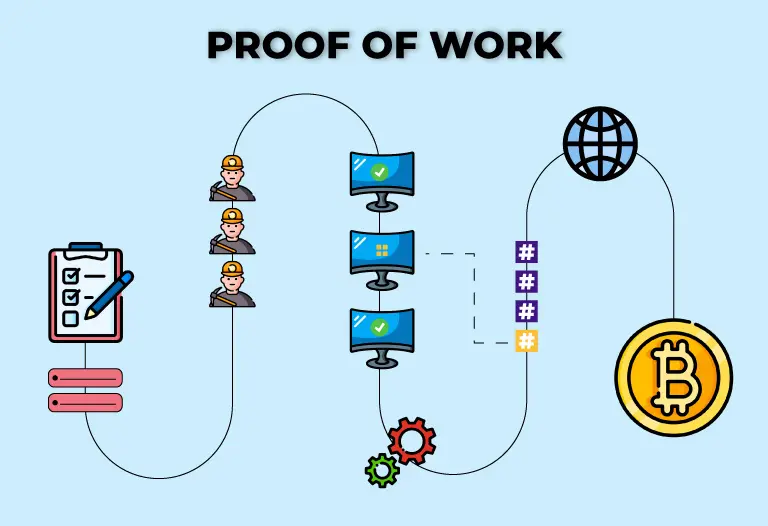Proof of Work: A Detailed Analysis in 2025
I bet you must have wrapped your mind around what Proof of Work stands out for in today’s crypto market, but peradventure you haven’t gotten a great deal of what it means and how it runs, I present you here and now, an ample opportunity to grasp in full the very basic operation(s) of Proof of Work consensus mechanism.
Yeah, you heard that right, Proof of Work is one of the many consensus mechanisms out in the Crypto space. You can’t talk about Proof of Work without talking about consensus mechanisms. So, quickly, what is the consensus mechanism?
What is a Consensus Mechanism?
Consensus mechanisms refers to the validatory process followed by cryptocurrencies to authenticate transactions. For every cryptocurrency, methods differ in so many ways, but the goal remains the same.
Consensus mechanisms are the foundational drivers of the blockchain network. They decide the individual methods adopted by any of the many digital currencies to validate and authenticate the countless number of transactions performed in their mining ecosystem.
Introduction to Proof of Work (PoW)
That being said, let’s hop into the business of the day – All you need to know about the Proof of Work consensus mechanism in 2025. In this article, attention will center mainly on PoW’s decentralization, energy, efficiency, security, and the competition it battles.
An In-Depth Analysis of PoW in 2025 – The Ultimate Guide for Every Crypto Enthusiast
The Proof of Work consensus mechanism hasn’t changed so much ever since its participatory role in furthering a decentralized economy began. Notably, the Proof of Work algorithm has thrived side by side with many other consensus mechanisms over the years.
Proof of Work is the driving force behind the validation exercise of Bitcoin, Dogecoin, Litecoin and many other notable digital coins that have enjoyed its covering over the years. Let’s take a sneaky peek into how the PoW operates and other relevant ideas.
How Proof of Work Operates
Miners are always in heated competition trying to figure out cryptographic puzzles that require a serious level of computational power. Any lucky miner who figures out the puzzle is allowed to broadcast a new block to the already existing large blockchain, which will then be verified or confirmed by other members of the network.
To be more emphatic, the “W” which stands for “Work” in PoW refers to the computational effort put in, to demystify this complex mathematical puzzle that holds the entire network. That is how the derivation “Proof of Work” came about. Hope you get the gist now.
Features of PoW
-
The PoW consensus mechanism is highly energy-intensive – it requires a reasonable amount of computational power and basic electricity.
-
Security is one of the PoW’s greatly priced treasures, and that explains why it assumes its preferred model. Let’s look at this way, since validation isn’t on the shoulders of one person but on that of the entire community, trying to alter a transaction in history might mean redoing all the computational work – that is some hell of work to try, so possible attacks are already mitigated.
-
The idea of decentralization means the entire community is accessible by anyone with the specified hardware and software.
PoW in 2025: Security, Decentralization, Efficiency, and Competitions
Security
The security architecture is still as tight as it has been during its early years of existence. The security network is built around computational difficulty, and that means trying to alter a single transaction can not go unnoticed.
Right now even in 2025, that top-tier security feature hasn’t changed because the entire architecture remains dauntlessly intact.
Decentralization
Originally, PoW was designed to be decentralized, but with the dominance of ASICs, mining pools and the rest, the question of how decentralized the network is has become a growing concern.
For mining pools, as more and more newbies partake under the canopy of a larger ecosystem, the question of control continues to be in doubt all the time, if few mining pools eventually dominate mining blocks. In addition, some geographic areas that are far advanced in technology are gradually usurping a greater percentage of the entire mining ecosystem.
Efficiency
Is the PoW still efficient for usage in 2025? This has lingered as one of the questions on the lips of many concerning the PoW consensus mechanism. These questions arise from those who are in the quest to find alternate options.
However, in light of today’s ever-pacing technology, PoW is not all that efficient in terms of energy-to-transaction. Although there are measures put in place to improve transaction efficiency such as Bitcoin’s lightning network.
Cheap Remote Crypto Mining for you – Click Here
Challenges and Competitors
Competition has risen to its peak in 2025, as there has been a mass introduction of other numerous consensus mechanisms. Proof of Stake (PoS), Proof-of-useful-work (PoUW) etc, are major drivers in their respective ecosystems.


